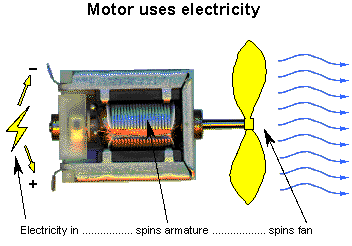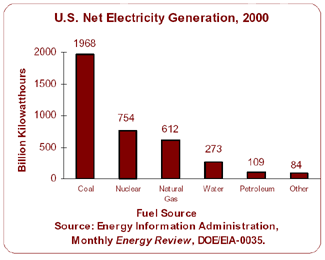ELECTRICITY GENERATION |  | ||||
A "generator" and "motor" are essentially the same thing: what you call it depends on whether electricity is going into the unit or coming out of it. A generator produces electricity. In a generator, something causes the shaft and armature to spin. An electric current is generated, as shown in the picture (lighting bolt). Lots of things can be used to make a shaft spin - a pinwheel, a crank, a bicycle, a water wheel, a diesel engine, or even a jet engine. They're different sizes but it's the same general idea. It doesn't matter what's used to spin the shaft - the electricity that's produced is the same. A motor uses electricity. In a motor, the electricity comes in through wires attached to the positive (+) and negative (-) terminals. The electric current causes the armature and shaft to spin. If there's just a little current and it's a small motor, it won't do very much work (i.e. it can only spin a small fan). If it's a large motor and it's using a lot of electricity, it can do a lot of work (i.e. spin a large fan very fast; lift a very heavy load; or whatever the motor is being used for). Electric generators are essentially very large quantities of copper wire spinning around inside very large magnets, at very high speeds. A commercial utility electric generator -- for example, a 180-megawatt generator at the Hawaiian Electric Company's Kahe power plant on Oahu -- can be quite large. It is 20 feet in diameter, 50 feet long, and weighs over 50 tons. The copper coils (called the "armature") spin at 3600 revolutions per minute. Although the principle is simple (copper wire and magnets), it's not necessarily easy! Steam turbine generators, gas turbine generators, diesel engine generators, alternate energy systems (except photovoltaics), even nuclear power plants all operate on the same principle - magnets plus copper wire plus motion equals electric current. The electricity produced is the same, regardless of source. 
A geothermal power plant is pretty much a steam power plant, since what comes out of the earth is steam. Rainwater soaks into the ground and goes down, down, down...far enough until it reaches a region which is really hot (in Hawaii, that's about 6000 feet). A well is drilled, the steam comes out, goes through a heat exchanger, and spins a turbine... turning the copper wire (armature) inside the generator and generating an electric current. By the time the steam has gone through the heat exchanger, it has cooled off and become warm water. It is then re-injected into the ground. In a gas turbine power plant, fuels are burned to create hot gases which go through a turbine, which spins...turning the copper armature inside the generator and generating an electric current. In a nuclear power plant, nuclear reactions create heat to heat water, which turns into steam, which goes through a turbine, which spins...turning the copper armature inside the generator and generating an electric current. In a wind turbine, the wind pushes against the turbine blades, causing the rotor to spin...turning the copper armature inside the generator and generating an electric current. In a hydroelectric turbine, flowing (or falling) water pushes against the turbine blades, causing the rotor to spin...turning the copper armature inside the generator and generating an electric current. Consumers expect electricity to be available whenever they plug in an appliance, turn a switch, or open a refrigerator. Satisfying these instantaneous demands requires an uninterrupted flow of electricity. In order to meet this requirement, utilities and nonutility electricity power producers operate several types of electric generating units, powered by a wide range of fuel sources. These include fossil fuels (coal, natural gas, and petroleum), uranium, and renewable fuels (water, geothermal, wind, and other renewable energy sources).
Steam-electric generating units burn fossil fuels, such as coal, natural gas, and petroleum. The steam turns a turbine that produces electricity through an electrical generator. Natural gas and petroleum are also burned in gas turbine generators where the hot gases produced from combustion are used to turn the turbine, which, and in turn, spins the generator to produce electricity. Additionally, petroleum is burned in generating units with internal-combustion engines. The combustion occurs inside cylinders of the engine, which is connected to the shaft of the generator. The mechanical energy provided from the engine drives the generator to produce energy.  In nuclear-powered generating units, the boiler is replaced by a reactor in which the fission of uranium is used to make steam to drive the turbine. Nuclear generating units accounted for the second largest share (20 percent) of electricity generation in the United States in 2000, 754 billion kWh. Hydro electricity units use flowing water to spin a turbine connected to a generator. In a falling water system, water is accumulated in reservoirs created by dams, then released through conduits to apply pressure against the turbine blades to drive the generator. In a run-of-the-river system, the force of the river current applies the pressure to the turbine blades to produce electricity. In 2000, hydroelectric generation had the fourth largest share (7 percent) of electricity production at 273 billion kWh.. Nonwater renewable sources of electricity generation presently contribute only small amounts (about 2 percent) to total power production. These sources include geothermal, refuse, waste heat, waste steam, solar, wind, and wood. Electricity generation from these sources in 2000 totaled 84 billion kWh. Total electric power industry generation in 2000 was 3,800 billion kWh, 2.5 percent greater than the 1999 total of 3,705 billion kWh. Of this total, utilities net generation for 2000 was 3,015 billion kWh, and net generation by nonutility power producers was 785 billion kWh |
infolinks
Archives
-
▼
2010
(111)
-
▼
December
(111)
- What is Physics
- Analysing scientific Investigation
- Understanding the Physics (and Errors) of the Meas...
- Understanding Scalar and Vector Quantities
- Understanding Derived and Base Quantities
- Understanding Physics
- Understanding Physics
- Power, Energy and Efficiency
- Work and Energy
- Understanding Elasticity
- Equilibrium and Statics
- Impulse and Impulsive force
- Analysing Momentum II
- Analysing Momentum
- Understanding Inertia
- Newtons Three Laws of Motion
- Distance, Displacement, Speed, Velocity, and Accel...
- Analysing Linear Motion
- Bernoulli's Principle Applied to Fluid Flow in Tubes
- Understanding Bernoulli's Principle
- Application of Archimedes' Principle
- Law of flotation
- What Causes Buoyant Force?
- Buoyant Force and Flotation
- Applying Archimedes' Principle
- Pascal's Principle
- Basic Hydraulic System
- Instruments for measuring Gas Pressure
- Instruments for measuring Atmospheric Pressure
- Applications of atmospheric pressure:
- Understanding Pressure And Atmospheric Pressure - ...
- Understanding Pressure in Liquids
- Understanding Pressure
- Uses of Gas Laws
- Universal Gas Laws
- Absolute Zero Temperature
- Pressure Law
- Charles' Law
- Boyle's Law
- Gases can be studied by considering the small sca...
- Understanding Gas Laws
- Specific Latent Heat
- Application of Specific Heat Capacity
- Specific heat capacity
- Heat Capacity
- Calibration of Thermometers
- Temperature Measurement:How...
- Understanding Thermal Equilibrium
- Relationship between Critical angle and Refractive...
- Total Internal Reflection
- Reflection of Light on a Curved Surface: Method to...
- Image Formation in Plane Mirrors
- Ray Optics, Light Refraction
- Understanding Reflection of Light: Law of Reflection
- Electromagnetic Spectrum
- Analysing Diffraction of Waves
- Analysing Reflection of Waves
- Understanding Waves
- Damping and Resonance of Waves
- Analysing Diffraction of Waves
- Speed of Sound
- Relationship between energy, voltage, current and ...
- Analyzing electrical energy and power
- Electromotive force and Internal Resistance
- Analyzing Electromotive force and Internal resistance
- EMF and Internal Resistance
- Internal Resistance
- Difference Between E.M.F and Potential Difference
- Electromotive Force
- The Effective Resistance of resistors connected in...
- Series and Parallel Circuits
- FUNDAMENTALS OF SUPERCONDUCTORS
- Resistance
- Ohm's Law
- The relationship between electric current and pote...
- Electric current as the rate of charge flow
- Electric Field
- Renewable Energy
- National Grid Network
- Transmission of Electricity
- Generation of Electricity
- Energy Losses in a Transformer
- Primary and Secondary Current in Transformer
- Step-Up and Step-Down Transformer
- TransformerA transformer makes use of Faraday's l...
- Direct and Alternating Current
- Applications of electromagnetic induction
- Lenz's Law
- Faraday's Law
- Induced Curent and Induced Electromotive Force
- Electromagnetic Induction
- Factors affecting the Speed of an Electromagnetic ...
- The force on a current-carrying conductor in a mag...
- Uses of Electromagnets
- Magnetic effect of current carrying conductor
- Electromagnetic Induction
- Uniderstanding Semiconductor Diodes
- Uses of Semiconductor Diodes
- Understanding Transistors
- Applications of Transistors
-
▼
December
(111)




0 Comments to "Generation of Electricity"
Leave a Reply